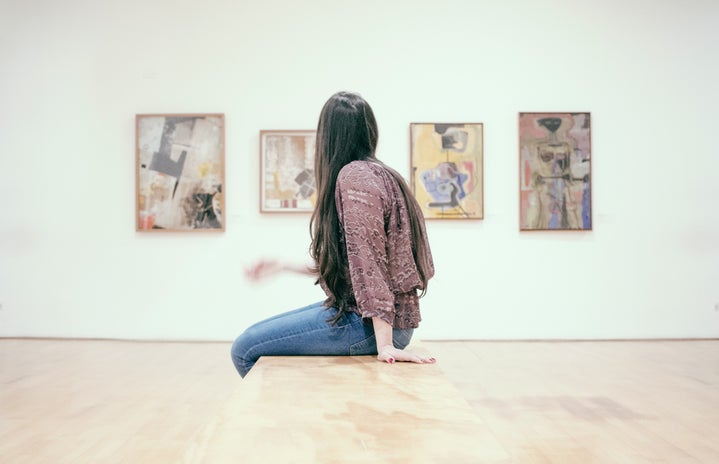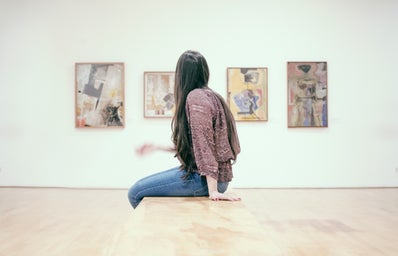It’s 4 a.m. and I shift slowly on the creaky bed. The heavy comforter sticks to my skin, pulling me closer like quicksand. Lying to my right, my sister is nothing but a tuft of roguish black curly hair bouncing in the sheets, older than me by a year yet still more free. Sliding silently to the striped matt on the floor, the underlying hardwood, nice and cool, grounds me from my nightmare.
I dreamed of dying. I do not know why or how I knew. I remember a feeling of bone jarring cold and the sinking feeling of missing a plane that was supposed to take you somewhere safe.
Rembrandt van Rijn, a Dutch painter, was famous for his collection of self-portraits depicting himself aging over the years.
Rembrandt’s searching eyes captivated me. The dark irises stare sadly slightly to the right, not quite meeting my eyes but seeming to beg me for an answer, for an escape. The pale white of his skin is a ghostly pallor, missing the warm red undertones of flesh, looking as though he is filled with silver blood, succumbing to the limited lighting from above. The lighting then goes to illuminate his shoulder, falling flat as if the planes of his shoulders used to be broader, used to fill his dark jacket better. Now, the creases fall a little short, making him seem less authoritative, juxtaposing his haughty side pose. I can imagine Rembrandt painting his expressions on his face over and over, wiping away the upward creases of his mouth, accidentally adding wrinkles to his forehead, eyes, and sunken cheeks. Lastly, the subject of the painting wears a plain jacket and beret, seemingly an afterthought yet the perfect plain background to highlight Rembrandt’s shifting facial expression and unease.
His 1659 Self-Portrait is especially poignant to me, a portrayal of the weight of his failures coupled with a posture traceable to other renowned painters of his time, potentially displaying the prominence he achieved over life. His old, lined face, his dark outfit and demeanor were a shadow of what he once was.
I was six years old when I decided I did not want to die, when I felt that unease of aging creeping up on me without realizing it. And there my parents found me a couple hours after, silently crying in front of my butterfly lamp, sitting on the mat at the base of my bed. Every tear was like a metronome, counting the seconds that passed as I pondered the eventual extinction of my own existence.
The god of death, Yama, is also called Dharmaraja. Dharmam is what is righteous or just, so Hindus have been viewing death as a holy experience of judgment for quite some time now. However, all our gods are portrayed as young and youthful, making me question whether death is truly desired in its truest form, without romanticizing it.
Rembrandt’s paintings play with darkness, never illuminating his whole face, never fully turning towards the light as I had that night. The 1659 Self-Portrait shows his wrinkles and solemn gaze that reads as a strangled cry for help or an abandonment of happiness. The painting is shortly after his bankruptcy and upheaval of financial position, and his struggle leaks into his paintings. Rembrandt recreated snapshots of himself over time, like the modern selfie. Did Rembrandt paint himself constantly because he was afraid of forgetting the reflections of his life?
As a Hindu, I believe in past and future lives. The way we interpret karma, it is a lifelong process. If your positive actions outweigh the negative ones, we believe that that individual accumulated positive karma that will manifest in their next life. But even more desirable is to end the cycle of reincarnation and reside only with God.
I do not know what number life I am on, all I know is that I want it to mean something, to count for others and for myself. Even Rembrandt’s influence remains as “ING and Microsoft collaborated to produce ‘The Next Rembrandt,’ a 3D printed object that closely resembles a Rembrandt painting” with technology. Or perhaps the use of a machine to replicate his work is a manifestation of his negative karma, as the portraits he tirelessly made can now be created using a machine.
However, instead of progressing and coming to terms with the idea that I will die eventually, my fear seems to be compounding. I notice myself frantically scheduling events within ten minutes of each other, and days where I feel like my time has been spent optimally, I feel satisfied and content. Yet other days, the weeks of sleepless nights and rushed nightly reviews leaves me with nothing but a headache and a desire that the paycheck from the new job I picked up could buy me some more time.
Rembrandt’s earlier portraits were signed with a “RHL” motif, a flourishing stroke of the brush before moving to “RHL-van-Rijn” and finally just “Rembrandt.” The change in signature seems like a change in categorization to me – a desperate plea that someone would remember his first name in his final portraits.
I know we are all powerless to the passage of time; one of the most famous lines from the Gita is, “I am time, the destroyer of all; I have come to consume the world.” I cannot evade or ignore this truth, but I wish that I could appreciate aging like other pious Hindus who praise Yama. But I cannot help but dictate how I live by how much time I have to spare.
Rembrandt’s work is often described as a kind depiction of aging opposed to taunting paintings that portray the elderly as haggard victims of time. They are a small break from the shockingly horrific pictures of aging that plague my nightmares. I prefer to imagine the frailty of growing older as a gentle and slow process, one that comfortably resides in the dark. Just as the Gita describes dying as, “no more traumatic than taking off an old coat,” I envision Rembrandt simply slipping further into the darkness, the darkness from his 1659 Self-Portrait covering his entire body as he rests in the grave.
Over the summer I got to see his work in person while I was studying abroad at the Scottish National Gallery, and all these emotions were amplified like never before.
I wish I could at least remember that nightmare I had that started this all or even speak to Rembrandt. Yet most of all, I wish I can fully experience life.


